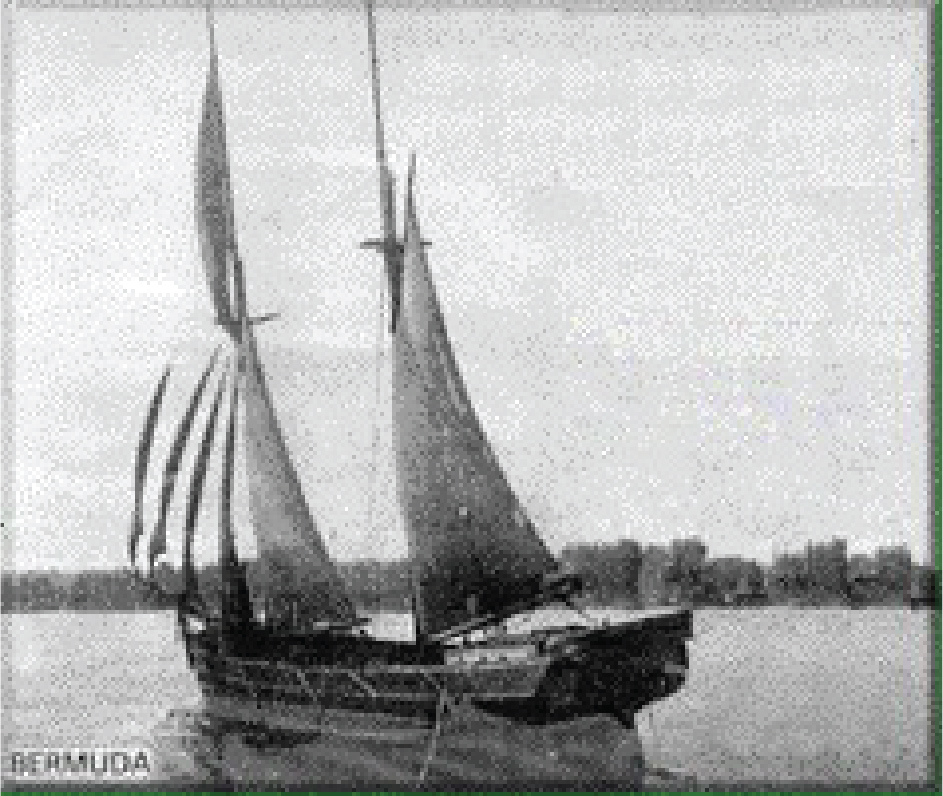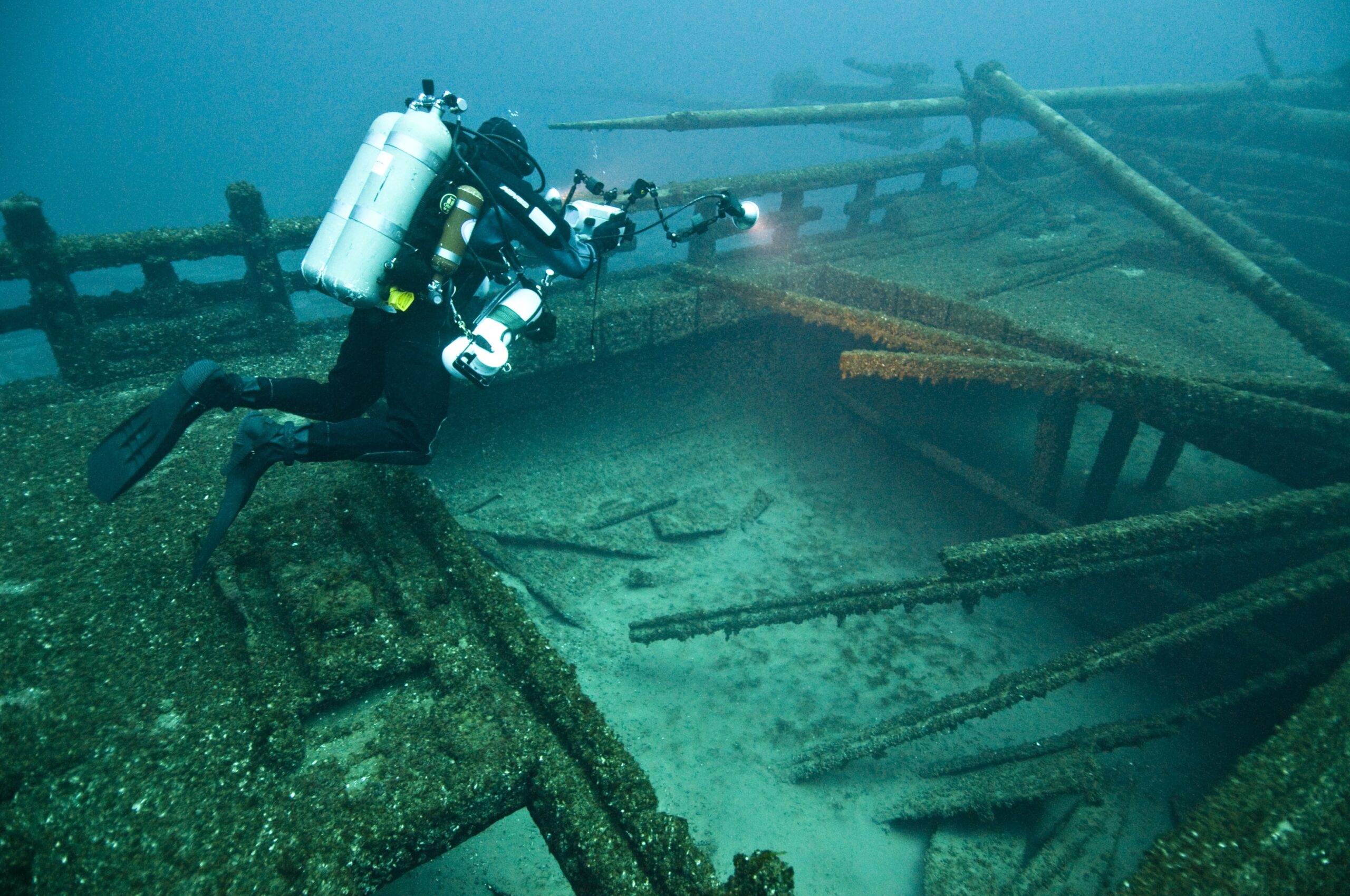The History
The Bermuda, a 150 foot wooden schooner foundered and sank in the spring of 1870 in Murray Bay on Grand Island. Her top deck is just 12 feet below the water’s surface where she has remained for 128 years. The wreck is intact, remarkable condition for a shallow wreck.
The cold water of Lake Superior rushed into the small forecastle with sledge hammer-like force. It slammed the sleeping crewmen against the hull planks, shocking them into confused consciousness. Their desperate struggles were to no avail. When they climbed into the rat hole of a forecastle they called home, all was right with the world, but it was here that three of the crew of the BERMUDA met their end.
After all these years, the schooner wreck in Murray Bay remains an
enigma. It has variously been identified as the W.W. ARNOLD,
GRANADA, DREADNAUGHT and BERMUDA. The best guess
though, is that it is the BERMUDA.
About the Ship
The two-masted BERMUDA was a typical canal schooner, one
designed to trade through the confining dimensions of the old Welland Canal between Lakes Ontario and Erie. Launched at Oswego, New York in April 1860, she was 136 feet in length, 26 feet in beam and 11 feet, 9 inches in depth. Her early years were spent in the grain trade between Lakes Michigan and Ontario. When the demand for iron ore increased, she shifted to carrying ore down from Marquette, MI.

The Mighty Superior Waters
On September 21, 1870 she left the lower lakes for Marquette with a
cargo of general supplies, arriving without incident. After loading 488 tons of ore she departed on October 14, but was overtaken by a gale off Grand Marais. The pounding of the waves caused her to start leaking and her captain brought her to shelter in Munising Bay where she reportedly filled and sank. When she left the docks in Marquette, it was said that she already had two feet of water in her hold. This would certainly cast doubt on the wisdom of her departure.
The story goes that Captain Michael Finney beached her near the
Anna River, near the present paper mill, making her fast to several
trees both fore and aft. Apparently the schooner continued to fill,
putting more and more pressure on the mooring lines. At about 8 p.m. the force was so great, it literally ripped the trees off the bank and the BERMUDA suddenly dropped to the bottom. All of her hands were carried down with her. Only the bursting of the cabin deck allowed some of the crew to escape from a watery grave. Three unlucky ones drowned.
Captain Finney and his remaining crew made their way to Marquette and reported their calamity. About a week later they returned to strip the schooner of anything useful and she was abandoned to the insurance underwriters. For practical purposes the BERMUDA just disappeared from the maritime scene.
Thirteen years later, in October 1883, Captain Higgins of the wrecking tug KATE WILLIAMS successfully raised the BERMUDA and towed her into Murray Bay. Once in the bay however, the lifting chains apparently slipped and the schooner settled on the bottom again. The WILLIAMS did manage to remove more than 120 tons of ore, but whether at the Anna River or in Murray Bay isn’t known. The following year the wrecking schooner JOHNSON attempted to raise the BERMUDA, but without success. In June of 1960 local scuba divers extensively salvaged much of the remaining ore cargo for souvenirs for a regional rock and mineral show.
Where is the Ship Now?
The Murray Bay wreck provides a near unique opportunity to study an intact mid-19th century canal schooner. The vessel lies in 25 feet of water in the shelter of the bay, protected from the ravages of Lake Superior’s storm waves and the grinding destruction of winter’s ice. Consequently, she remains in remarkably good condition; her only major wounds are those inflicted by her salvagers.
All of the vessel’s spars and rigging are gone, but the locations of her
two masts are still apparent. The foremast hole can be seen about 30 feet from the bow. The BERMUDA had three hatches giving access to the cargo hold, as well as two companionways and the large cabin trunk near the stern. The deck between the forward and aft hatches is badly broken, probably from the 1883 and 1884 salvage operations. The port rail for some 55 feet at the stern has been torn loose, most likely by modern dive boats before the establishment of the Alger Underwater Preserve and the current system of mooring buoys. What looks like a heavy wooden bulkhead running down the center of the hull and visible through the midships cargo hatch and broken decking is actually the
centerboard trunk with the centerboard still raised up in it.
The large rectangular opening near the stern marks the location of the BERMUDA’s trunk cabin, which contained the galley and quarters for some of her crew.
Over the years, diver traffic on the wreck has resulted in the destruction of some bulkheads, as well as the loss of an iron stove and other artifacts which could tell about the sailors’ lives. With the establishment of the Underwater Preserve and the education of divers about the cultural importance of shipwrecks, the deterioration of the wreck has slowed dramatically.
